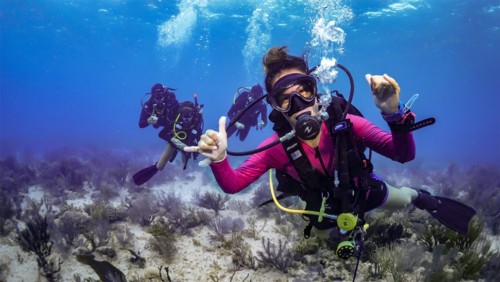 Online Scuba Lessons |
 Online Nitrox Lessons |
Bubble Mechanics
Scuba Diving
A Physics Lesson all scuba divers should know.



In nearly every Basic Scuba Diver class, at least one student says that he or she heard that "you just follow your bubbles up" or "don't go faster than your bubbles". This is a very common misconception. The misconception is that if you follow your smallest exhaust bubbles you will not exceed an ascent rate of 60 feet per minute (the maximum ascent rate for recreational diving). This assumes that all bubbles ascend at less than 60 feet per minute. Let's take a look at this concept and see if it is safe to simply follow your bubbles.
First, I want to apply the laws of Physics that are taught in the Basic Scuba Diver course. When a diver exhales bubbles into the water, the bubbles begin to expand as they rise. As they expand they increase their buoyancy and therefore travel to the surface with increasing speed which causes them to expand faster and travel even faster towards the surface.
Second, it is extremely difficult to follow bubbles, especially when there are more than a few divers, there is poor visibility, or when there is substantial current.
Third, it is extremely difficult to slow your ascent rate after you have passed the bubble you were watching. By the time your realize that your gaining on your bubble, its to late - You are going to fast!
Forth, 60 feet per minute is too fast to begin with! Many hyperbaric specialists throughout the world are now recommending an ascent rate of 30 feet per minute. NAUI has adopted this ascent rate of all diving activities, save one. The Emergency Swimming Ascent, for which 60 feet per minute cannot be exceeded.
TIME OUT:
Just for grins, try this. Mark off 60 feet on the floor, or
your drive way. Then walk 60 feet per minute - it should
take you a full 30 seconds to walk only half way and a full 60
seconds to walk the entire 60 feet - right? Now walk at 30
feet per minute - it should take you a full two minutes to walk
the 60 feet. Now you can begin to realize how slow this
actually is. Count 1001, 1002, 1003, etc. and move 6 inches
for each count. In two minutes you will have traveled only
60 feet.
OK, TIME IN:
Some dive computers utilize a number of different ascent rates,
depending on the depth. For example, the Oceanic DataMax and
the Prodigy computers both have multiple ascent rate algorithms
with the slower ascent rates near the surface. Remember, the
greatest pressure change is between 15 and 0 feet. This is
the danger zone. Make darn sure you ascend slowly the last
15 feet - 10 feet per minute is not to slow! And always stop
at 15 feet for at least 2 - 3 minutes to allow your body to
eliminate some of that excess nitrogen buildup before you release
most of the pressure.
If a diver chooses a conservative No Decompression Dive, ascends slowly, and stops at 15 feet for 3 minutes, bubble formation in the blood and body tissues and subsequent bubble growth can be greatly reduced. A safety stop has other benefits too. If a diver carefully controls his ascent to stop before surfacing, he or she will be less likely to ascend rapidly through the last 15 feet. The stop also allows the diver to get organized, adjust gear, look and listen for surface hazards.
So, forget about your bubbles, ascend slowly, and stop at 15
feet. It's safer than following your bubbles.
Sea you on the next dive boat...
Bwana
![]()